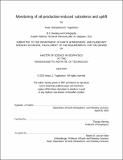| dc.contributor.advisor | Thomas Herring. | en_US |
| dc.contributor.author | Togaibekov, Anuar Zhanybekovich. | en_US |
| dc.contributor.other | Massachusetts Institute of Technology. Department of Earth, Atmospheric, and Planetary Sciences. | en_US |
| dc.coverage.spatial | a-kz--- | en_US |
| dc.date.accessioned | 2020-09-03T17:49:29Z | |
| dc.date.available | 2020-09-03T17:49:29Z | |
| dc.date.copyright | 2020 | en_US |
| dc.date.issued | 2020 | en_US |
| dc.identifier.uri | https://hdl.handle.net/1721.1/127149 | |
| dc.description | Thesis: S.M. in Geophysics, Massachusetts Institute of Technology, Department of Earth, Atmospheric, and Planetary Sciences, May, 2020 | en_US |
| dc.description | Cataloged from the official PDF of thesis. | en_US |
| dc.description | Includes bibliographical references (pages 97-101). | en_US |
| dc.description.abstract | A number of human activities associated with the petroleum industry are known to trigger or even induce anthropogenic earthquakes of varying magnitudes. Examples of the damages of the infrastructure in oil and gas fields due to production make clear the need to monitor processes in the field. Land surface deformation is one method that can yield insights into geodynamic processes. Knowledge of the processes can lead to mitigation approaches. This Master's thesis focuses on the application of geodetic techniques to study land-surface deformations associated with oil and gas production. In particular, it focuses on optimizing existing methodology based on the example of the data from one of the oilfields in the western part of Kazakhstan. The geodetic techniques used for this project include interferometric synthetic aperture radar (InSAR), continuous and campaign global positioning system (GPS) surveying, precise leveling surveying, and gravimetric measurements. The data set, spanning 11 years, was reprocessed to improve the results of the existing standard processing procedures using more sophisticated software packages and reducing uncertainties and/or noise. The thesis also suggests the field-work protocols that may increase the accuracy of the measurements. The results of the project will allow the application of the developed methodology to the monitoring of oil-production-induced subsidence and uplift in the Republic of Kazakhstan and elsewhere. | en_US |
| dc.description.statementofresponsibility | by Anuar Zhanybekovich Togaibekov. | en_US |
| dc.format.extent | 101 pages | en_US |
| dc.language.iso | eng | en_US |
| dc.publisher | Massachusetts Institute of Technology | en_US |
| dc.rights | MIT theses may be protected by copyright. Please reuse MIT thesis content according to the MIT Libraries Permissions Policy, which is available through the URL provided. | en_US |
| dc.rights.uri | http://dspace.mit.edu/handle/1721.1/7582 | en_US |
| dc.subject | Earth, Atmospheric, and Planetary Sciences. | en_US |
| dc.title | Monitoring of oil-production-induced subsidence and uplift | en_US |
| dc.type | Thesis | en_US |
| dc.description.degree | S.M. in Geophysics | en_US |
| dc.contributor.department | Massachusetts Institute of Technology. Department of Earth, Atmospheric, and Planetary Sciences | en_US |
| dc.identifier.oclc | 1191839303 | en_US |
| dc.description.collection | S.M.inGeophysics Massachusetts Institute of Technology, Department of Earth, Atmospheric, and Planetary Sciences | en_US |
| dspace.imported | 2020-09-03T17:49:29Z | en_US |
| mit.thesis.degree | Master | en_US |
| mit.thesis.department | EAPS | en_US |
